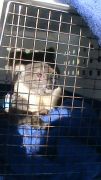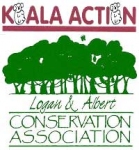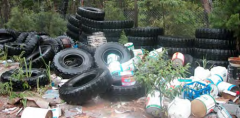
Logan and Albert Conservation Association

New partnership for wildlife carers
 This koala was rescued on 5 October 2011, and taken to Daisy Hill Koala Sanctuary. He was euthanased at Moggil Hospital due to his being blind (from having had conjunctivitus and cystitis) and not having a suitable habitat to be released. He was 6 years old. Apparently if his habitat was denser he would be fine to survive as they usually rely mainly on smell and hearing (in a koala with normal sight). They do release koala's that are blind.
This koala was rescued on 5 October 2011, and taken to Daisy Hill Koala Sanctuary. He was euthanased at Moggil Hospital due to his being blind (from having had conjunctivitus and cystitis) and not having a suitable habitat to be released. He was 6 years old. Apparently if his habitat was denser he would be fine to survive as they usually rely mainly on smell and hearing (in a koala with normal sight). They do release koala's that are blind.
Image aside is one of the photos of the koala "rescued" by a local wildlife carer.
The new partnership between DERM and RSPCA ,Qld and the carer network would strengthen the overall care of wildlife in Queensland by combining resources and providing a united approach. RSPCA Qld and DERM have driven this change to improve coordination and response times, and reduce the time that animals are in distress according to Mr Bradley from RSPCA
The change to 1300 ANIMAL means the caller will speak directly to an experienced RSPCA Qld operator who will arrange an appropriate response. The partnership covered various aspects of the management and regulation of protected wildlife rescue, care and rehabilitation.
The new arrangements will be trialed for 12 months from 1 September, and DERM has contributed $60,000 to support the improved response and the RSPCA's package of improved networking, training and communication for the wildlife carer network. DERM will still be responsible for issuing wildlife rehabilitation permits.
The care and rehabilitation of sick, injured and orphaned wildlife is delivered through a dedicated volunteer network of licensed wildlife carers throughout Queensland. RSPC Qld currently has approximately 400 'wildlife heroes' who are available to conduct the rescue of sick, injured or orphaned animals and who support wildlife carers and that number is set to increase following a recruitment drive.
DERM ensures that wildlife care is done according to best practice and meets the expectations of the broader community through a Code of Practice for carers.
Read that code here. I have some reservations about the code. Hopefully there will be an open review after 12 month trial period.
You can see the presentation delivered to wildlife carers here. New partnership for wildlife care information is here
The greatest threat to our local koalas in the LACK OF POLITICAL WILL TO CREATE LEGISLATION TO PROTECT THEIR HABITAT.
 The Department of Environment and Resource Management (DERM) has invested resources in the management and delivery of wildlife and inventory information to its internal and external clients. The Environmental Information Systems Unit is the custodian of the WildNet and Wetland Information Capture System (WIC) applications and works with DERM and external partners for the acquisition and delivery of a range of wildlife and survey information.
The Department of Environment and Resource Management (DERM) has invested resources in the management and delivery of wildlife and inventory information to its internal and external clients. The Environmental Information Systems Unit is the custodian of the WildNet and Wetland Information Capture System (WIC) applications and works with DERM and external partners for the acquisition and delivery of a range of wildlife and survey information.
The reporting of wildlife - both dead and alive - to DERM IS A CRITICAL ACTION for all citizens to do.
WHY is reporting of wildlife SO IMPORTANT?
Sightings are entered into a data base and are used in DESKTOP STUDIES by consultants researchers and others to help compile environmental assessments that are part of development applications.Sometimes the citizen scientists' wildlife sightings may be the only record.
Wildlife Online allows internet users to request species lists for selected areas, specified points or defined areas. The options include species (all, plant or animal), type (all, native or introduced), status (all or rare and threatened), records (all, confirmed or specimen), date (all or since 1980) and output (pdf or text file).
Species lists for protected areas (national parks, conservation parks and resources reserves), forestry areas (State forests and timber reserves) and Local Government Areas in
Users can also request species lists generated from summarised sighting data for buffered points or defined areas using coordinates (decimal degrees). The submitted requests are processed every 15 minutes and the resultant species lists are sent to the user’s email account as an attachment. The species outputs includes kingdom, class, family, scientific name, common name, introduced flag, NCA status, EPBC Act status, number of records and number of specimens.
For more information about
LACA Logan and Albert Conservation Association strongly urges all new residents in any area to find out what wildlife has been recorded in the area and also to continue to update the online database. This list can also be useful to help you identify a spcies you see in your area. The information has been adapted from a document DERM sent to us. This is that document. DERM_Internet_Wildlife_Information_Systems012011.doc 113.50 Kb 18/02/2011, 17:34
DERM_Internet_Wildlife_Information_Systems012011.doc 113.50 Kb 18/02/2011, 17:34
LACA also has an online form you can fill in which we forward to DERM. Locate this in lefthand column front page. While sightings of koalas are critical because there are some planning regulations that may help - though they are still inadequate - all species are important.
 The Department of Environment and Resource Management (DERM) is undertaking a substantial waste reform program comprising three main elements: a new waste strategy, new legislation, including a new Act and an industry waste levy.
The Department of Environment and Resource Management (DERM) is undertaking a substantial waste reform program comprising three main elements: a new waste strategy, new legislation, including a new Act and an industry waste levy.
Queensland's Waste Strategy 2010 – 2020 Waste Avoidance and Recycling Consultation Draft can be read and downloaded here. It is a 44 page pdf document.
A stakeholder advisory committee will be appointed to provide advice to the Minister on the strategy's implementation, including preparation of the necessary legislative measures.
Submissions on the draft strategy can be made until 31 July 2010. Please note: this date has been extended at the request of stakeholders.
Submissions may also be forwarded by post or fax. Send your submission to:
Project Manager – Queensland's Waste Strategy consultation
Natural Resources and Environment
Department of Environment and Resource Management
GPO Box 2454
BRISBANE QLD 4001
Phone 13 13 04 Fax: 07 3330 5996
Submissions must be received by the closing date and include:
the name and address of each submitter
the signature of each submitter (an electronic scan is acceptable for email submissions)
the reason for the submission
a statement of the facts and circumstances supporting the submission.
When making a submission, please ensure that direct quotes or comments are referenced with the relevant section of the strategy.